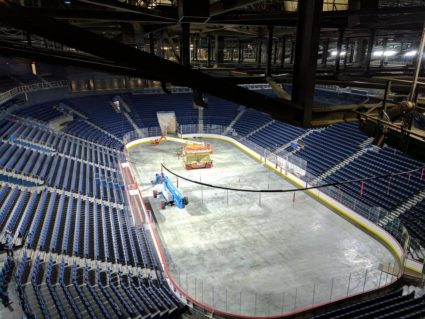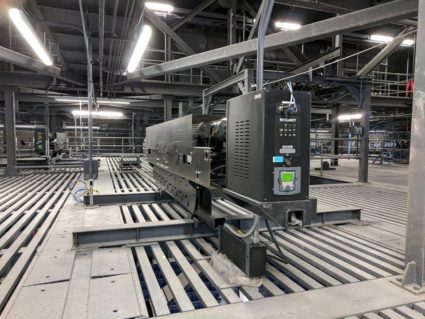Teaming Up: Performances in Hockey Arenas
Across North America, the NHL’s Stanley Cup playoffs are underway. Hockey arenas echo with sound of slap shots, bone-jarring checks and roaring crowds. Ever wonder how these venues transform from hosting hockey games one night to a rock concert or other performances the next? As in successful playoff hockey, the answer is teamwork.
Winning Collaboration
Niscon and J.R. Clancy have joined forces to outfit a number of new hockey arenas across North America with the innovative equipment including hoists, rigging, control hardware and software necessary to make these transformations not only possible, but relatively fast and easy.
“The challenge is changing over the arena quickly with as few people as possible,” says Joe Jeremy, CEO of Niscon, based in Burlington, Ontario. Niscon designs software, controllers and operator interfaces for chain hoists, motors and rigging systems.
“Before hosting a concert or other event you’ve first got to get hockey out of the way,” he adds. This could include moving the scoreboard, some of the arena’s sound-reinforcement speakers and certain lighting. To create a performance backdrop for concerts, curtains are often suspended from the ceiling to block off certain seating. “Getting the building’s rigging out of the way frees up space for the tour riggers to come in and hang their points,” Jeremy explains, adding that touring shows are growing in size and complexity.
Two-Way Players
He marvels at the massive logistical efforts behind traveling shows. “When a Cirque du Soleil arena show arrives at an arena, there might be 12 to 18 trucks hauling as much as 170,000 pounds of equipment,” he says. “Within 12 hours it’s all unloaded and they’re ready to rehearse – you’ve got to experience this to believe it.” Six hours later everything’s done and the show is ready for an audience. Just four hours after the show ends, the equipment is packed up and hits the road again. The scale of a typical rock show is smaller, but still requires from 8 to 16 trucks, four hours of setup and two hours of tear down.
These touring acts benefit from rapid changeovers, as do the facility owners who can book more performances in hockey arenas to maximize revenue. For example, Centre Bell in Montreal, which bills itself as the largest hockey arena in North America, has over 21,000 seats and hosts one million hockey fans annually. Centre Bell also welcomes 650,000 more people attending 120 concerts and special events. Niscon and J.R. Clancy recently teamed up to help upgrade Centre Bell’s control systems and related rigging, motors and hoists. G.C. Stage Equipment of Quebec expertly handled the project’s design, engineering, installation and coordination.
Accepting Challenges
Jeremy says Niscon’s partnership with J.R. Clancy has proven popular with arena owners and theatrical consultants alike. “They like the combination of Clancy equipment and Niscon controls and software, plus the way we address specific project challenges,” he remarks. “These consultants often have a technical, hands-on background; they know what works best and why.”
Unique to hockey arenas are the custom hoists that raise and lower the spectator nets that help protect fans from flying pucks. Each net may weigh 300 pounds, with another 400 pounds of pressure required to achieve the necessary tension. If too much pressure is applied, the net could pull the acrylic glass out of the dasher boards. J.R. Clancy, Niscon and the consultant work together to provide the proper solution for moving these nets and other arena-specific needs.
Jeremy believes that his firm’s Raynok software is a key differentiator in the increasingly global marketplace. It’s designed to control everything from the simplest chain hoist systems to the most complex hoisting, turning, pushing or pulling application. The software is fully customizable, which gives the operator flexibility to choose how to sort and display the information. Jeremy adds that wireless controls and interfaces are becoming more popular today.
Smooth Results
While the best control equipment – wireless or wired – is intuitive and user-friendly, implementing these solutions effectively requires training to ensure proper operation and maximum benefits. Niscon and J.R. Clancy personnel usually provide on-site system training for arena personnel. A simple installation may require 6 to 8 hours of training, more complex arena systems twice that amount.
To assist with premiere concert performances in hockey arenas or other unique circumstances, Niscon and J.R. Clancy often provide on-site standby assistance to ensure everything runs as smoothly as a freshly resurfaced ice sheet. So the next time you’re in a hockey arena and the puck drops or your favorite band starts singing in concert, we hope you now can better recognize the behind-the-scenes efforts and equipment that helps make the magic happen.






Leave a Reply